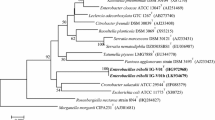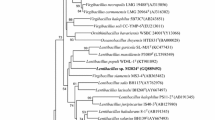Abstract
A polyphasic taxonomic study using morphological, biochemical, chemotaxonomic and molecular genetic methods was performed on six strains of unknown Gram-positive, nonspore-forming, facultative anaerobic coccus-shaped bacteria isolated from a swine-manure storage pit. On the basis of the 16S rRNA, RNA polymerase α-subunit (rpoA) and 60 kDa chaperonin (cpn60) gene sequence analyses, it was shown that all the isolates were enterococci but formed two separate lines of descent. Pairwise 16S rRNA gene sequence comparisons demonstrated that the two novel organisms were most closely related to each other (97.9 %) and to Enterococcus aquimarinus (97.8 %). Both organisms contained major amounts of C16:0, C16:1 ω7c, C16:1 ω7c, and C18:1 ω7c/12t/9t as the major cellular fatty acids. Based on biochemical, chemotaxonomic and phylogenetic evidence, the names Enterococcus lemanii sp. nov. (type strain PC32T = CCUG 61260T = NRRL B-59661T) and Enterococcus eurekensis sp. nov. (type strain PC4BT = CCUG 61259T = NRRL B-59662T) are proposed for these hitherto undescribed species.



Similar content being viewed by others
References
Andrighetto C, De Dea P, Lombardi A, Neviani E, Rossetti L, Giraffa G (1998) Molecular identification and cluster analysis of homofermentative thermophilic lactobacilli isolated from dairy products. Res Microbiol 149:631–643
Bryant MP (1972) Interactions among intestinal microorganisms. Am J Clin Nutr 25:1485–1487
Cotta MA, Whitehead TR, Zeltwanger RL (2003) Isolation, characterization and comparison of bacteria from swine faeces and manure storage pits. Environ Microbiol 5:737–745
Cotta MA, Whitehead TR, Falsen E, Moore E, Lawson PA (2009) Robinsoniella peoriensis gen. nov., sp. nov., isolated from a swine-manure storage pit and a human clinical source. Int J Syst Evol Microbiol 55:150–155
Dehority BA, Grubb JA (1976) Basal medium for the selective enumeration of rumen bacteria utilizing specific energy sources. Appl Environ Microbiol 32:703–710
Descheemaeker P, Lammens C, Pot B, Vandamme P, Goossens H (1997) Evaluation of arbitrarily primed PCR analysis and pulse-field gel electrophoresis of large genomic DNA fragments for identification of enterococci important in human medicine. Int J Syst Bacteriol 47:555–561
Feilberg A, Dezhao L, Adamsen A, Hansen M, Jonassen K (2010) Odorant emissions from intensive pig production measured by online proton-transfer-reaction mass spectrometry. Environ Sci Technol 44:5894–5900
Harwood VJ, Whitlock J, Withington V (2000) Classification of antibiotic resistance patterns of indicator bacteria by discriminant analysis: use in predicting the source of fecal contamination in subtropical waters. Appl Environ Microbiol 66:3698–3704
Hespell RB, Wolf R, Bothast RJ (1987) Fermentation of xylans by Butyrivibrio fibrisolvens and other ruminal bacteria. Appl Environ Microbiol 53:2849–2853
Johnson JL (1994) Similarity analysis of DNAs. In: Gerhardt P, Murray RGE, Wood WA, Krieg NR (eds) Methods for general and molecular bacteriology. ASM, Washington, DC, pp 656–682
Le P, Aarnink A, Ogink N, Becker P, Verstegen M (2005) Odour from animal production facilities: its relationship to diet. Nutr Res Rev 18:3–30
Leedle JA, Hespell RB (1980) Differential carbohydrate media and anaerobic replica plating techniques in delineating carbohydrate-utilizing subgroups in rumen bacterial populations. Appl Environ Microbiol 39:709–719
Marks R (2001) Cesspools of shame: how factory farm lagoons and sprayfields threaten environmental and public health. Report from NRDC and the Clean Water Network. http://www.nrdc.org/water/pollution/cesspools/cessinx.asp
Miescier JJ, Cabelli VJ (1982) Enterococci and other microbial indicators in municipal wastewater effluents. J Water Pollut Control Fed 54:1599–1606
Miller LT (1982) Single derivatization method for routine analysis of bacterial whole-cell fatty acid methyl esters, including hydroxy acids. J Clin Microbiol 16:584–586
Miller DN (2001) Accumulation and consumption of odorous compounds in feedlot soils under aerobic, fermentative, and anaerobic respiratory conditions. J Anim Sci 79:2503–2512
Naser SM, Thompson FL, Hoste B, Gevers D, Dawyndt P, Vancanneyt M, Swings J (2005) Application of multilocus sequence analysis (MLSA) for rapid identification of Enterococcus species based on rpoA and pheS genes. Microbiology 151:2141–2150
Nicholas KB, Nicholas HB Jr, Deerfield DW II (1997) GeneDoc: analysis and visualization of genetic variation. EMBNEW News 4:14
Page RD (1996) TreeView: an application to display phylogenetic trees on personal computers. Comput Appl Biosci 12:357–358
Pearson WR, Lipman DJ (1988) Improved tools for biological sequence comparison. Proc Natl Acad Sci USA 85:2444–2448
Rasmussen SW (2002) SEQtools, a software package for analysis of nucleotide and protein sequences. http://www.seqtools.dk. Accessed 3 Aug 2012
Saito H, Miura K-I (1963) Preparation of transforming deoxyribonucleic acid by phenol treatment. Biochim Biophysica Acta 72:619–629
Saitou N, Nei M (1987) The neighbor-joining method: a new method for reconstructing phylogenetic trees. Mol Biol Evol 4:406–425
Sasser M (1990) Identification of bacteria by gas chromatography of cellular fatty acids, in: MIDI technical note 101. MIDI, Inc., Newark
Sistek V, Maheux AF, Boissinot M, Bernard KA, Cantin P, Cleenwerck I, de Vos P, Bergeron MG (2011) Two novel species, Enterococcus ureasiticus sp. nov. and Enterococcus quebecensis sp. nov., isolated from water. Int J Syst Evol Microbiol. doi:10.1099/ijs.0.029033-0
Stackebrandt E, Ebers J (2006) Taxonomic parameters revisited: tarnished gold standards. Microbiol Today 33:152–155
Stackebrandt E, Goebel BM (1994) Taxonomic note: a place for DNA–DNA reassociation and 16S rRNA sequence analysis in the present species definition in bacteriology. Int J Syst Bacteriol 44:846–849
Švec P, Devriese LA (2009) Genus I. Enterococcus. In: de Vos P, Garrity GM, Jones D, Kreig NR, Rainey FA, Schleifer K-H, Whitman WB (eds) Bergyey’s manual of systematic bacteriology, vol 3, 2nd edn. The Firmicutes, Springer, New York, pp 594–607
Švec P, Vancanneyt M, Devriese LA, Naser SM, Snauwaert C, Lefebvre K, Hoste B, Swings J (2005) Enterococcus aquimarinus sp. nov., isolated from sea water. Int J Syst Evol Microbiol 55:2183–2187
Thompson JD, Higgins DG, Gibson TJ (1994) Clustalw: improving the sensitivity for progressive multiple sequence alignment through sequence weighting, position-specific gap penalties and weight matrix choice. Nucleic Acids Res 22:4673–4680
Tindall BJ, Sikorski J, Smibert RM, Kreig NR (2007) Phenotypic characterization and the principles of comparative systematics. In: Reddy CA, Beveridge TJ, Breznak JA, Marzluf G, Schmidt TM, Snyder LR (eds) Methods for general and molecular microbiology. ASM Press, Washington, DC, pp 330–393
Vermette C, Russell A, Desai A, Hill J (2010) Resolution of phenotypically distinct strains of Enterococcus spp. in a complex microbial community using cpn60 universal target sequencing. Microb Ecol 59:14–24
Wayne LG, Brenner DJ, Colwell RR, Grimont PAD, Kandler O, Krichevsky MI, Moore LH, Moore WEC, Murray RGE, Stackebrandt E, Starr MP, Triiper HG (1987) Report of the Ad Hoc Committee on reconciliation of approaches to bacterial systematics. Int J Syst Bacteriol 37:463–464
Weiss A, Domig KJ, Kneifel W (2005) Comparison of selective media for the enumeration of probiotic enterococci from animal feed. Food Technol Biotechnol 43:147–155
Whitehead TR, Cotta MA (2001) Characterization of microbial populations in swine feces and waste storage pits by 16S rDNA gene sequence analysis. Anaerobe 7:181–187
Whitehead TR, Cotta MA (2004) Isolation and identification of hyper-ammonia producing bacteria from swine manure storage pits. Curr Microbiol 48:20–26
Whitehead TR, Flint HJ (1995) Heterologous expression of an endoglucanase gene (endA) from the ruminai anaerobe Ruminococcus flavefaciens 17 in Streptococcus bovis and Streptococcus sanguis. FEMS Microbiol Lett 126:165–169
Whitehead TR, Cotta MA, Collins MD, Lawson PA (2003) Description of Hespellia stercorisuis gen. nov., sp. nov., and Hespellia porcinus sp. nov., isolated from manure storage pits. Int J Syst Evol Microbiol 54:241–245
Whitehead TR, Cotta MA, Collins MD, Falsen E, Lawson PA (2005) Bacteroides coprosuis sp. nov., isolated from swine-manure storage pits. Int J Syst Evol Microbiol 55:2515–2518
Acknowledgments
The authors wish to acknowledge Janet Hill, Department of Veterinary Microbiology, Western College of Veterinary Medicine, University of Saskatchewan, Canada for assistance with the analysis of the cpn60 gene sequences. The authors also wish to acknowledge the valuable technical assistance by Rhonda Zeltwanger.
Author information
Authors and Affiliations
Corresponding author
Electronic supplementary material
Below is the link to the electronic supplementary material.
Rights and permissions
About this article
Cite this article
Cotta, M.A., Whitehead, T.R., Falsen, E. et al. Two novel species Enterococcus lemanii sp. nov. and Enterococcus eurekensis sp. nov., isolated from a swine-manure storage pit. Antonie van Leeuwenhoek 103, 89–98 (2013). https://doi.org/10.1007/s10482-012-9789-9
Received:
Accepted:
Published:
Issue Date:
DOI: https://doi.org/10.1007/s10482-012-9789-9




